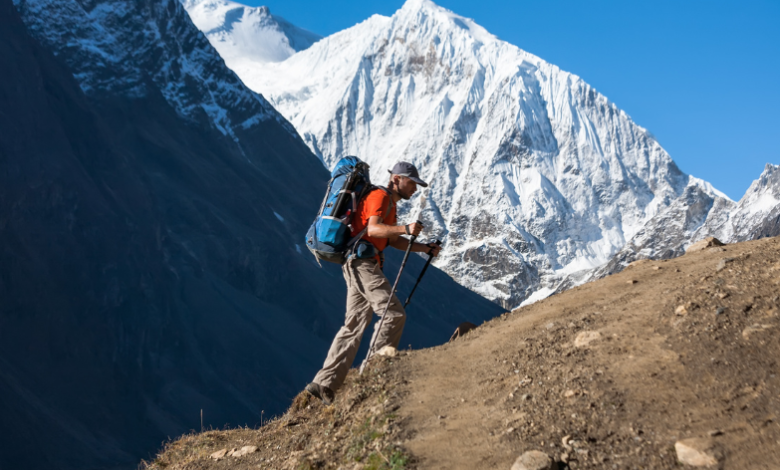Recommended Best Side Trips in Manaslu Trek

The Manaslu trekking region is among the best locations in Nepal for trekking and vacationing. Every year, a significant number of tourists from all over the world come to this place. Nestled deep within Nepal’s majestic Himalayas, the Manaslu Circuit Trek offers guests an experience of a lifetime with its breathtaking scenery, affluent society, and serene mountain views. Nestled deep within Nepal’s majestic Himalayas, the Manaslu Circuit Trek offers guests an experience of a lifetime with its breathtaking scenery, affluent society, and serene mountain views. While undertaking the Manaslu Trek, you may come upon some of the best side trips.
Rui La, Nepal –Tibet border (4998m, 16593ft.)
Assuming Samdo is the starting point, there are basically two routes to the Tibetan border. First option: enjoying the view from Lajyung Bhanjyang Pass, which is 5098 meters east of Samdo. The locals do not recommend traveling this route because it is not well-traveled and the trail is unclear (Yaks are the dominating people in these hills and have marked numerous trails there). The second path, dubbed the “main way to Tibet,” goes through the Rui La pass, which is 4998 meters north of Samdo, and connects to the trade route to Tibet. The nearest Tibetan village can be reached on foot in a day via this trail, whereas a motorized road on the Tibetan side would take two days to reach. One could succeed
The hike starts by leaving Samdo and traveling north toward Dharamshala. It then crosses the Athahra Saya Khola and climbs back up the other side. That being said, instead of heading west towards Dharamshala, you head north along the western flank of the Athahra Saya Khola. Once the trail crosses a small river on a wooden bridge and descends softly towards the riverbed, it climbs steadily alongside the Athahra Saya Khola. Then it climbs back up and follows the river’s western bank. Walking from Samdo, the Athahra Saya Khola turns westward after three hours.
crosses this location; a steep slope leading to distant mountain passes is located beyond it. After you cross the bridge, begin your ascent. The trail looks confused at first because there are several Yak routes ascending from its base, but it soon becomes clear that the direction you want to go is up. At 4998 feet, the peak of the Rui La pass requires two more hours of climbing. Along the trip, you may catch stunning views of Manaslu in the distance as well as the Hindu and Fukang glaciers right behind you. The Rui La pass is a “classic” mountain pass that forms a “U”.
A border stone and prayer flags mark the boundary between Nepal and China’s “Dzong Who”. Views of other mountain ranges may be seen from the Tibetan side, and if you’re lucky, you can get a sight of a Yak caravan crossing the pass to transport supplies into Nepal. It takes around four hours to retrace the route to Samdo, so if you plan to do this, prepare for a long day. Bring lots of water, prepare a sandwich, and set off early.
Serang Gompa (3100m, 10170ft.)
A unique Tibetan Buddhist retreat, Serang Gompa, also called Nubri Monastery, is nestled in a little meadow amid the high Himalayan slopes. It is hard to believe that this little oasis, perched above these wild southern Himalayan hills and spanning the boundaries of Nepal and Tibet, has survived for five centuries. Situated above Bhi Village on the Manaslu Trek trail lies the monastery. Bhi village is the closest populated spot for accomodation, unless you want to camp.
The neighboring community attaches great spiritual significance to the monastery, where more than thirty mountain youngsters are studying Buddhism. Bhi village is where this detour begins. Leave the lodge with a full backpack of food and beverages. Hikers seldom venture to one of the area’s secret beauties; follow a steeply upward-facing track through the pine forest. A day trip provides amazing views of Mount Manaslu’s top and lush valley, as well as Siringi Himal, Ganesh Himal, and others. A close-up view of rare musk deer and Himalayan peasants awaits you as a prize. If you have camping gear, continue the trip to Tsum Valley. The Kopan monastery in Kathmandu receives assistance from both the neighborhood and the monastery itself.
Kal Tal ‘Death Lake’ (3600m, 11808ft.)
Kal Tal, sometimes referred to as “Death Lake,” is a breathtaking yet foreboding natural wonder 3,600 meters (11,808 feet) above sea level. This lake, which is surrounded by untamed mountains, is shrouded in mystery and folklore; its name alone arouses suspicion and caution.
The mysterious roots of the foreboding appellation “Kal Tal” are just as mysterious as the lake itself. Tales from the area’s folklore speak of ghosts hanging over its coast and brave adventurers going missing. Some wonder if the lake is cursed, while others wonder if the secrets of a lost civilization are hidden beneath its surface.
Kal Tal is known for its unpleasant reputation, but it also has unmatched natural beauty. The lake, surrounded by soaring hills that reflect on its immaculate surface, has an alluring deep blue color and water so transparent that the lake bed is apparent. There seems to be a fine line separating the worlds of the living and the dead early in the morning when mist rises from the water’s surface.
Few people travel to Kal Tal since getting there requires a strenuous trek through difficult terrain. Nonetheless, pilgrims are rewarded with a deep sensation of amazement and awe that is uncommon elsewhere. The majesty and enigma of the natural world, where the temptation of the unknown is constant, are attested to by Kal Tal’s bleak grandeur.
Hinang Gompa and Himalchuli Base Camp (4020m, 13186ft.)
Nestled within Nepal’s stunning Himalayan landscapes are two remarkable retreats: Himalchuli Base Camp and Hinang Gompa. These places provide spiritual and ecological treasures.
Hinang Gompa, also called Hinang Monastery, is a highly respected Buddhist monastery nestled in the Manaslu region of Nepal at an elevation of roughly 3,100 meters (10,170 feet). This medieval monastery holds great religious value and serves as a refuge for learning, prayer, and meditation. With beautiful peaks and lush environs, it offers a tranquil haven for people looking for spiritual fulfillment as well as outdoor enthusiasts.
The hike to Hinang Gompa is an adventure unto itself, often involving forging through steep terrain and clear mountain streams. Along the way, travelers may expect breathtaking views of snow-capped peaks, roaring waterfalls, and charming Nepalese villages nestled into lovely valleys. Through the tour, visitors can fully immerse themselves in the pristine magnificence of the Himalayas, offering a profound sense of tranquility and connection with nature.
The Himalchuli Base Camp is situated at 4,020 meters (13,186 feet) above sea level, and adventurers can reach there on a wonderful journey from Hinang Gompa. Himalchuli, one of Nepal’s most famous peaks, towers at an incredible height of 7,893 meters (25,896 ft). The base camp offers an enthralling vantage point to see Himalchuli, Ngadi Chuli, and Manaslu, among other magnificent Himalayan vistas.
There are benefits and obstacles unique to trekking to the Himalchuli Base Camp, including steep climbs, unpaved paths, and high-altitude temperatures. Nevertheless, the stunning surroundings and the sense of accomplishment upon reaching the base camp make it an extremely memorable experience. While there, visitors can stroll around, enjoy the stunning scenery, and feel the tranquility of the Himalayan landscape.
Visits to Hinang Gompa and the Himalchuli Base Camp enable one to learn about Nepal’s rich cultural heritage and stunning landscape. Whether you’re seeking adventure, spiritual enlightenment, or just a peaceful retreat in the arms of nature, these places ensure an incredible experience filled of wonder and astonishment.
Phungen Gompa (Around 4050m, 11316ft.)
Nestled in the breathtaking Himalayan landscape, Phungen Gompa is a revered Buddhist monastery situated at an elevation of around 4050 meters (11,316 ft). This historic hideaway offers guests spiritual serenity in addition to breath-taking vistas of the surrounding snow-capped peaks and verdant valleys. It is positioned majestically on a mountainside.
Situated in a remote part of the Himalayas, Phungen Gompa is a symbol of the ongoing spiritual legacy of Tibetan Buddhism in the region. The monastery serves as a hub for religious education, meditation, and social gatherings for the locals as well as pilgrims and tourists who go to this remote part of the world in quest of serenity and enlightenment.
When Phungen Gompa was built, local craftsmanship and traditional Tibetan aesthetics were seamlessly blended together. The vivid prayer flags flapping in the mountain breeze and the whitewashed walls adorned with intricate paintings depicting scenes from Buddhist texts create a serene and ethereal atmosphere that enthralls both tourists and devotees.
Sacred books may be found in the monastery complex’s library, prayer halls adorned with antique statues of Buddhist deities, and meditation rooms where monks practice spiritual exercises and introspection. Holy and devotional energy permeates the air, especially when one hears monks chanting through the corridors.
There are plenty of opportunities for adventure and discovery in the wild environment outside the monastery walls. Trekking routes meander through pristine woods, cascading streams, and alpine meadows covered in wildflowers, offering hikers a great opportunity to connect with nature and appreciate the pure beauty of the Himalayan terrain.
For those who prefer spiritual retreats and cultural immersion, Phungen Gompa caters to their needs by providing opportunity to participate in religious rites, meditation retreats, and traditional festivals that are actively and fervently observed by the local population.
A visit to Phungen Gompa is a pilgrimage to a sacred location where the beauty of the Himalayas envelops the soul and time seems to stand still, not just to view a remote monastery. Here, ancient wisdom coexists with the beauty of nature, and the comforting embrace of the mountains lifts the soul.
Birenda Tal (3450m, 11316ft.)
At 3450 meters (approximately 11,316 feet) high, Birenda Tal is a clean alpine lake located in Nepal’s stunning Himalayan region. Hikers and animal enthusiasts who travel to the Manaslu region hold a special place in their hearts for this tranquil pond, which is surrounded by breathtaking vistas of the mountains.
Tucked away on the popular Manaslu Circuit walking route, Birenda Tal offers a peaceful sanctuary in the middle of the wild surroundings. King Birendra Bir Bikram Shah, who ruled Nepal from 1972 until his tragic death in 2001, is honored by the lake’s name. Thanks to its tranquil ambiance and stunning natural beauty, trekkers may unwind and rejuvenate at this lovely place as they navigate the strenuous Himalayan terrain.
The breathtaking image that is produced when the shimmering waters of Birenda Tal reflect the surrounding snow-capped peaks astounds visitors. Towering giants like Mt. Manaslu, Manaslu North, and Naike Peak offer a dramatic background that adds even more allure to this lovely lake.
Many hikers feel a sense of accomplishment and satisfaction upon reaching Birenda Tal, particularly after crossing the difficult Himalayan terrain. The trek always has a sense of excitement because reaching the lake often involves leaping over streams, cutting through lush forests, and navigating rugged terrain.
During the trekking season, which typically runs from March to May and September to November, hikers can camp at Birenda Tal to fully immerse themselves in the Himalayan natural magnificence. The sun sets behind the beautiful peaks, creating a palette of brilliant hues that wonderfully bathes the tranquil lake waters in a wonderful light.
In addition to being beautiful from a scenic standpoint, Birenda Tal holds cultural significance for the residents of the neighboring villages. The colorful prayer flags that are regularly flown along its borders symbolize the spiritual links that bind the people to the land, and it provides freshwater to both people and animals.
Whether it’s a peaceful retreat in the middle of nature or a demanding trek into the Himalayan foothills, Birenda Tal offers an incredible experience for anyone seeking adventure, calm, and the unparalleled beauty of Nepal’s mountainous environment.
Manaslu Base Camp (4900m, 16072ft.)
Manaslu Base Camp Trek, at an elevation of 4900 meters, or around 16,072 feet, is the beginning point for one of the most stunning and challenging mountain climbing experiences on earth. Located at the foot of the eighth-highest mountain in the world, 8,163-meter (26,781-foot) Mount Manaslu, this base camp offers breathtaking vistas, wild surroundings, and an exhilarating sense of adventure. This base camp will appeal to adventurers’ aesthetic sense.
The base camp, which is situated inside the Manaslu Conservation Area, is where climbers who want to reach the top of Mount Manaslu start their ascent. This remote camp can only be reached by trekking through a variety of landscapes, from lush forests and cascading waterfalls to stony, barren land topped with towering hills. Trekking is not recommended for the faint of heart.
Hikers get a unique opportunity to completely immerse themselves in the region’s rich cultural tapestry as they ascend to Manaslu Base Camp, passing through quaint towns that are home to indigenous tribes like the Gurungs and Sherpas. Along the way, trekkers can learn about the long-standing customs and traditions of the local people, as well as enjoy genuine Nepalese cuisine and warm hospitality.
Hikers can enjoy expansive views of snow-capped peaks, including the majestic Manaslu, as they go deeper into the Himalayas. Even if the air gets thinner and each step requires more effort, the allure of reaching base camp keeps adventurers motivated.
When trekkers reach Manaslu Base Camp, they are rewarded with stupendous views of the surrounding mountains, including the massive massif of Manaslu dominating the horizon. The camp itself is a simple arrangement of tents with the minimal essentials for hikers and climbers, put up on rough terrain. Considering how straightforward the trip is, what makes it so spectacular is the sense of accomplishment and camaraderie among fellow explorers.
The base camp offers an ideal setting for acclimatization and last-minute preparations prior to the arduous journey for climbers aiming to summit Manaslu. Climbers spend many days honing their technical skills, getting used to the higher altitude, and preparing their route of ascent.
Naturalists and travelers from all over the world come to Manaslu Base Camp because it embodies the spirit of exploration and adventure. Whether visiting to witness the unparalleled grandeur of the Himalayas or taking on the ultimate climbing challenge, this remote outpost offers an experience that visitors will never forget.



